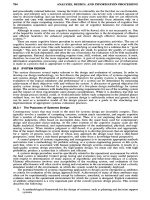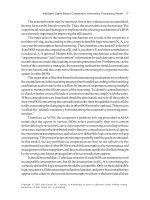- Trang chủ >>
- Khoa Học Tự Nhiên >>
- Vật lý
pollicott m., yuri m. dynamical systems and ergodic theory (web version, cup, 1998)(194s)
Bạn đang xem bản rút gọn của tài liệu. Xem và tải ngay bản đầy đủ của tài liệu tại đây (1.65 MB, 194 trang )
PRELIMINARIES
1. Conventions. The book is divided into 16 chapters, each subdivided
into sections numbered in order (e.g. chapter 12, section 3 is numbered 12.3).
Within each chapter results (Theorems, Propositions or Lemmas) are la-
belled by the chapter and then the order of occurrence (e.g. the fifth result
in chapter 3 is Proposition 3.5). The exceptions to this rule are: sublem-
mas which are presented within the context of the proof of a more important
result (e.g. the proof of Theorem 2.2 contains Sublemmas 2.2.1 and 2.2.2);
and corollaries (the corollary to Theorem 5.5 is Corollary 5.5.1).
We denote the end of a proof by .
Finally, equations are numbered by the chapter and their order of occur-
rence (e.g. the fourth equation in chapter 5 is labelled (5.4))
2. Notation. We shall use the standard notation: R to denote the
real numbers; Q to denote the rational numbers; Z to denote the integer
numbers; N to denote the natural numbers; and Z
+
to denote the non-
negative integers. We use the convenient convention that: R/Z = {x +
Z : x ∈ R} (which is homeomorphic to the standard unit circle); R
2
/Z
2
=
{(x
1
, x
2
) + Z
2
: (x
1
, x
2
) ∈ R
2
} (which is homeomorphic to the standard 2-
torus); etc. However, for x ∈ R we denote the corresponding element in R/Z
by x (mod 1) (and similarly for R
2
/Z
2
, etc.).
We denote the interior of a subset A of a metric space by int(A), and we
denote its closure by cl(A).
If T : X → X denotes a continuous map on a compact metric space then
T
n
(n ≥ 1) denotes the composition with itself n times.
If T : I → I is a C
1
map on the unit interval I = [0, 1] then T
denotes its
derivative.
3. Prerequisites in point set topology (chapters 1-6). The first six
chapters consist of various results in topological dynamics for which the only
prerequisite is a working knowledge of point set topology for metric spaces.
For example:
Theorem A (Baire). Let X be a compact metric space; then if {U
n
}
n∈N
is a countable family of open dense sets then
n∈N
U
n
⊂ X is dense.
xi
xii PRELIMINARIES
Theorem B (sequential compactness). Let X be a metric space;
then X is compact if and only if every sequence (x
n
)
n∈N
in X contains a
convergent subsequence.
Theorem C (Zorn’s lemma). Let Z be a set with a partial ordering. If
every totally ordered chain has a lower bound in Z then there is a minimal
element in Z.
Two good references for this material are [4] and [5]
4. Pre-requisites in measure theory (chapters 7-12). Chapters 7-
12 form an introduction to ergodic theory, and suppose some familiarity (if
not expertise) with abstract measure theory and harmonic analysis. The
following results will be required.
Theorem D (Riesz representation). There is a bijection between
(1) probability measures µ on a compact metric space X (with the Borel
sigma algebra),
(2) Continuous linear functionals c : C
0
(X) → R,
given by c(f ) =
fdµ.
Theorem E. Let (X, B, µ) be a measure space. For every linear func-
tional α : L
1
(X, B, µ) → L
1
(X, B, µ) there exists k ∈ L
∞
(X, B, µ) such that
α(f) =
f · kdµ, ∀f ∈ L
1
(X, B, µ) [3, p.121].
In proving invariance of measures in examples the following basic result
will sometimes be assumed.
Theorem f (Kolmogorov extension). Let B be the Borel sigma-
algebra for a compact metric space X. If µ
1
and µ
2
are two measures for the
Borel sigma-algebra which agree on the open sets of X then m
1
= m
2
[3, p.
310].
The following terminology will be used in the chapter on ergodic measures.
Given two probability measures µ, ν we say that µ is absolutely continuous
with respect to ν if for every set B ∈ B for which ν(B) = 0 we have that
µ(B) = 0. We write µ << ν and then we have the following result.
Theorem G (Radon-Nikodym). If µ is absolutely continuous with re-
spect to µ then there exists a (unique) function f ∈ L
1
(X, B, dν) such that
for any A ∈ B we can write µ(A) =
A
fdν.
We usually write f =
dµ
dν
and call this the Radon-Nikodym derivative of µ
with respect to ν.
We call two measures µ, ν mutually singular if there exists a set B ∈ B
such that µ(A) = 0 and ν(A) = 1. We then write µ ⊥ ν.
In chapter 8 we shall need a passing reference to Lebesgue spaces. A
Lebesgue space is a measure space which is measurably equivalent to the
PRELIMINARIES xiii
the union of unit intervals (with the usual Lebesgue measure) with at most
countably many points (with non-zero measure).
In chapter 11 we shall use the following result.
Theorem H (dominated convergence). Let h ∈ L
1
(X, B, µ) and let
(f
n
)
n∈Z
+
⊂ L
1
(X, B, µ), with |f
n
(x)| ≤ h(x), converge (almost everywhere) to f(x);
then
f
n
dµ →
fdµ as n → +∞.
Good general references for this material are [1], [2], [3].
5. Subadditive sequences. A simple result which proves its worth
several times in these notes is the following.
Theorem F (subadditive sequences). Let (a
n
)
n∈N
be a sequence of
real numbers such that a
n+m
≤ a
n
+ a
m
, ∀n, m ∈ N (i.e. a subadditive
sequence); then a
n
→ a, as n → +∞, where a = inf{a
n
/n: n ≥ 1}
Proof. First note that a
n
≤ a
1
+ a
n−1
≤ . . . ≤ na
1
, and so a ≤ a
1
For
> 0 we choose N > 0 with a
N
< N (a + ). For any n ≥ 1 we can write
n = kN + r, where k ≥ 0 and 1 ≤ r ≤ N − 1. Then
a
n
≤ a
kN
+ a
r
≤ ka
N
+ a
r
≤ ka
N
+ sup
1≤r≤N
a
r
and we see that
lim sup
n→+∞
a
n
n
≤ lim sup
k→+∞
ka
N
+ sup
1≤r≤N
a
r
kN
=
a
N
N
≤ a + .
This shows that
a
n
n
→ a, as required.
References
1. P. Halmos, Measure Theory, Van Nostrand, Princeton N.J., 1950.
2. K. Partasarathy, An Introduction to Probability and Measure Theory, Macmillan, New
Delhi, 1977.
3. H. Roydon, Real Analysis, Macmillan, New York, 1968.
4. G. Simmons, Introduction to Topology and Modern Analysis, McGraw-Hill, New York,
1963.
5. W. Sutherland, Introduction to Topological and Metric spaces, Clarendon Press, Ox-
ford, 1975.









